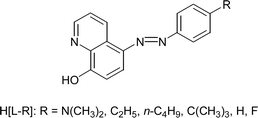Investigations on the electronic effects of the peripheral 4′-group on 5-(4′-substituted)phenylazo-8-hydroxyquinoline ligands: zinc and aluminium complexes†
Abstract
A new series of 5-(4′-substituted)phenylazo-8-hydroxyquinolines (H[L–R]; R = N(CH3)2, I, C2H5, II, n-C4H9, III, C(CH3)3, IV, H, V and F, VI) has been prepared and the corresponding Zn[L–R]2 (1a–6a) and Al[L–R]3 (1b–6b) complexes successfully synthesized. These compounds have been studied in order to design new molecular materials with enhanced electron transport properties. The obtained species have been extensively characterized by absorption and ![[double bond, length as m-dash]](https://www.rsc.org/images/entities/char_e001.gif) N–C6H4–N(CH3)2 group, are further proved by a reversible electron transfer process detected by
N–C6H4–N(CH3)2 group, are further proved by a reversible electron transfer process detected by


 Please wait while we load your content...
Please wait while we load your content...